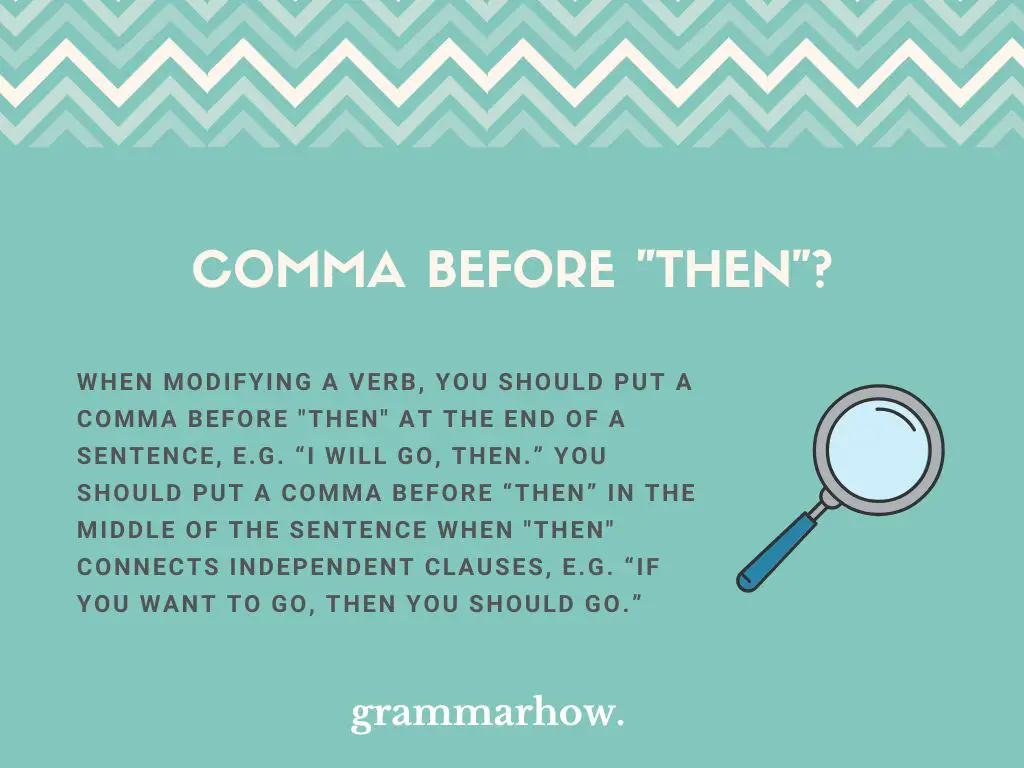“Then” is a common English adverb. It comes up a lot, and even native speakers have a hard time understanding where to put the comma when using it. This article will explain all you need to know about “then” and its comma rules.
Comma Before “Then”?
When modifying a verb, you should put a comma before “then” at the end of a sentence, e.g. “I will go, then.” You should put a comma before “then” in the middle of the sentence when “then” connects independent clauses, e.g. “If you want to go, then you should go.”

If you can’t already tell, “then” is a very versatile adverb. You can use it in all kinds of situations, meaning that commas apply to it in many different ways. There’s a lot to remember when using commas with “then,” so let’s get stuck in.
First, it’s worth knowing that The Chicago Manual of Style and The AP Stylebook agree on the comma rules here. They suggest using commas with “then” whenever it appears in a sentence, and a natural pause would appear if you said the sentence aloud.
Similarly, APA Style agrees with this comma rule. All three style guides use this rule to make it easier for English speakers to “sound-out” the comma placement. If you say a sentence aloud, you should be able to teach yourself where a comma goes.
These are the most basic ways to place a comma before “then:”
- I will not go, then.
- If you don’t want to be here, then maybe you should just leave.
The first shows “then” as an adverb modifying the verb “go.” It comes at the end of the sentence, meaning a comma must come before.
The second shows an “if/then” construct. Here, you can compare two elements and include a comma before “then” when introducing the “then” issue.
When to Place a Comma Before “Then”
Commas can come before “then” in many situations. It’s a versatile adverb, allowing it to be punctuated in multiple situations.
You should place a comma before “then” in the middle of a sentence when it’s part of an “if/then” clause or connecting two independent clauses. This is common, so you need to know what separates these two things.
The “if/then” clause is simple. It shows you how one thing might cause another to happen:
- If you don’t listen to me, then you’re not going to get very far.
- If you don’t want to see her, then you don’t have to.
- If you had told us that sooner, then you could have avoided this drama.
You may also place a comma before “then” when connecting two independent clauses. Here’s an example of how that looks:
- I will not go there later, then I won’t have to deal with him.
This is grammatically correct, but it’s not common. “Then” isn’t a conjunction, meaning it shouldn’t be used to connect clauses like this. It’s best to place a semi-colon before “then” rather than a comma. Both are correct, but the semi-colon makes more sense in formal writing.
You may also place a comma before “then” when it comes at the end of a sentence. This is done when it is an adverb modifying another verb.
Here are some examples:
- I will have to see you later, then.
- I’m not sure you know what you’re doing, then.
- I’ll talk to him, then.
When to Use “Then” Without a Comma
You do not always need to use a comma with “then.” There are a few instances where it’s not necessary.
“Then” means “after that” as an adverb. A comma does not need to come before or after it when used to modify a modal verb or adjective. You also don’t need to place a comma around it when “then” describes the order of your actions.
Here are some quick examples showing you when a comma does not belong with “then:”
- There was one, but then there were two.
- I will go to the shops and then to the theatre. What do you think?
- I could have told you that and then made it easier for you.
Comma After “Then”?
You may place a comma after “then” at the beginning of a sentence when it’s an introductory clause or adverb. This means it modifies the sentence as a whole or introduces a new clause to the reader.
Here are some examples of how it might work:
- I could have done that for you. Then, we wouldn’t have had to worry about this.
- I thought about my options briefly. Then, I took it upon myself to get out there.
- You made the most of it. Then, you threw your opportunity away.
You can also place a comma after “then” in the middle of a sentence, but only when a new clause comes directly after it. If “then” is the last word of an independent clause, you may find that a comma naturally falls after it.
If you’re unsure about this, read the sentence aloud. This should help you figure out where the commas belong. Here’s what we mean:
- I needed to be there then, but I wasn’t sure where everyone was.
What to Remember
A comma comes before “then” at the end of the sentence when modifying a verb from before. You can read the sentence aloud to test whether you need to take a brief pause. If you do, place the comma before “then.”
A comma comes after “then” when it starts a sentence. In most cases, “then” has a comma after it when it’s an introductory clause.
You may avoid commas completely if “then” describes the order of your actions. In this form, “then” modifies a modal verb that comes after it.
